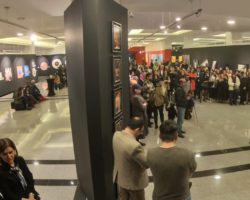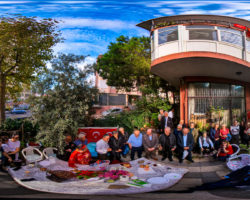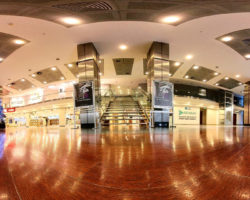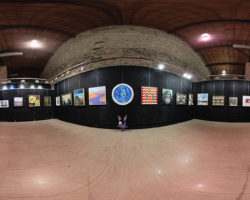[kml_flashembed publishmethod=”static” fversion=”8.0.0″ movie=”http://www.sanalfotograf.com/ugurakbulut/at-meydani.swf” width=”680″ height=”450″ targetclass=”flashmovie” allowfullscreen=”true”]
[/kml_flashembed]
© Uğur Akbulut – www.sanalfotograf.com
| Sultanahmet Meydanı İstanbul’un en önemli meydanlarından biridir. Bizans devrinde Hipodrom olarak bilinirdi. “Hipodrom” At binenlerin, atların meydanı anlamına gelir. Osmanlı döneminde buraya At Meydanı denirdi.
Günümüze çok az kalıntıları kalan Bizans devri önemli yapıları ve abideleri Hipodrom çevresinde inşa edilmişti. “Büyük Saray” diye bilinen İmparatorluk Sarayı Hipodromun yanından başlar, aşağılara, deniz kenarına kadar uzanırdı. Bu Saraydan günümüze bir büyük salonun yer mozaik panosu gelebilmiştir. Şehrin en önemli meydanı Agusteion ve burası ile cadde arasında Milerium zafer takı bulunurdu. Cadde Roma’ya kadar uzanan yolun başlangıcı idi ve ilk kilometre taşı da buradaydı. Hamamlar, mabetler, dini, kültürel, idare ve sosyal merkezler bu civara yerleşmişlerdi. Semt Bizans ve Türk devirlerinde de merkezi önemini devam ettirmiştir. İstanbul’un en önemli abideleri Ayasofya, Sultan Ahmet Camii, Türk ve İslam Eserleri Müzesi, Yerebatan Sarnıcı burada, Hipodromun çevresindedirler. Şehrin ana caddeleri (aşağı limana inen ve batıya şehir surlarına doğru gidenler) Hipodromdan başlar ve yamaçları takip ederdi. Yol kenarları ticari kuruluşlar ve ikametgahlarla çevrili idi. Yan yollar dar ve bazıları basamaklarla yokuş aşağı uzanırlardı. Anayol kaldırımları bazen iki katlı, galerili inşa edilmişlerdi. Roma İmparatorluğu ve sonradan Bizans İmparatorluğu devrinde hipodrom şehrin toplantı, eğlence, heyecan ve spor merkezi olarak 10 yüzyıla kadar önemini sürdürmüştü. Araba yarışları yanında, müzisyen toplulukları, dansözler, akrobatlar, vahşi hayvanlarla kavga gösterileri, toplantılar yapılırdı. Bütün bu faaliyetler için ise Roma devrinde bol tatil günleri mevcuttu. Dev ölçüde bir U harfi şeklinde olan hipodromun doğu uzun tarafında, damında 4 bronz at bulunan, balkon şeklinde, imparator locası yer alırdı. Ortada, hipodromun kum kaplı sahasını ikiye bölen, arabaların etrafında yarıştığı alçak bir duvar, bu duvarın üstünde de İmparatorluğun çeşitli yerlerinden getirilen abideler ve meşhur at yarışçıları ile atlarının heykelleri bulunurdu. Şöhretli bir araba yarışçısı akla gelebilecek her türlü maddi olanak içinde yüzerdi. Yarışçılar yeşil-mavi-sarı-kırmızı gibi politik güçleri de olan takımlara ayrılmışlardı. Zaman, zaman yarışlara politika karışır, karşılıklı güçlerin mücadeleleri korkunç katliamlara dönüşebilirdi. Hipodrom günümüze zemini 4-5 metre yükselmiş ve kalabilmiş 3 abide ile gelmiştir. Bunlar Mısır’dan getirilen Obelisk, Yılanlı Sütun ve Örme Obelisktir. Osmanlı devrinde, bu meydanda bazen, eski günlerindeki zengin gösteriler gibi, çeşitli festival ve gösteriler tertiplenmişti. Hipodrom’un batısında, Sultan Ahmet Camii’nin karşısında yer alan Kanuni’nin sadrazamı İbrahim Paşa Sarayı 16. yy. zengin ve tipik özel sarayların günümüze gelen tek örneğidir. Bu güzel yapı Türk ve İslam Eserleri Müzesi olarak ziyarete açıktır. Hipodromdan günümüze yuvarlak güney ucu kalmıştır. Bu büyük kemerlerle donatılmış tuğla bir yapıdır. Sonraki devirlerde Hipodromun taş blokları ve sütunlarının tamamı başka yapılarda kullanılmıştır. Hipodrom girişi sağındaki parkta 4-5 yy. ait özel saray kalıntıları, az ilerisinde de Aya Öfemiya Bizans Kilisesinin kalıntıları bulunmaktadır. Osmanlı zamanında da Yeniçeri isyanları bu bölgede gerçekleşir, kırk gün kırk gece süren şehzade sünnet düğünleri, şenlikler burada yapılırdı. İstanbul’da Halide Edip’in işgale karşı konuşma yaptığı 1920 Sultanahmet mitingi de burada yapılmıştır. Sultan Ahmet meydanının yanında Yerebatan Sarnıcı ve Binbir direk sarnıcı bulunmaktadır. Binbir direk sarnıcında 224 sütun direk bulunur ve 4. yüzyılda yapıldığı tahmin edilmektedir.Yere batan sarnıcı ise 336 sütundan oluşur ve MS (527-565) de yapılmıstır. Osmanlı döneminde 2şer kez restore edilen bu sarnıçlar. Şuan kültürel faaliyetler için halkın kullanımına açılmıştır. Meydanın orta yerinde Kayzer Wilhelm’in ziyaret hatırası olarak yapılmış olan Alman Çeşmesi bulunmaktadır. Meydanın batısında ise İstanbul Adliyesi yer almaktadır. Meydan günümüzde İstanbul’un en önemli turistik merkezidir. “Sultanahmet Meydanı.” Wikipedia, Özgür Ansiklopedi. 15 Ekim 2009, 19:49 UTC. 2 Kas 2009, 22:18 <http://tr.wikipedia.org/w/index.php?title=Sultanahmet_Meydan%C4%B1&oldid=6564386>. ———————————————————————————————————————————————————————— ENGLISH The Hippodrome of Constantinople (Turkish: Sultanahmet Meydanı, At Meydanı) was a circus that was the sporting and social centre of Constantinople, capital of the Byzantine Empire. Today it is a square named Sultanahmet Meydanı (Sultan Ahmet Square) in the Turkish city of Istanbul, with only a few fragments of the original structure surviving. It is sometimes also called Atmeydanı (Horse Square) in Turkish. The word hippodrome comes from the Greek hippos (‘ιππος), horse, and dromos (δρομος), path or way. Horse racing and chariot racing were popular pastimes in the ancient world and hippodromes were common features of Greek cities in the Hellenistic, Roman and Byzantine eras. History and use In AD 324, the Emperor Constantine the Great decided to move the seat of the government from Rome to Byzantium, which he renamed Nova Roma (New Rome). This name failed to impress and the city soon became known as Constantinople, the City of Constantine. Constantine greatly enlarged the city, and one of his major undertakings was the renovation of the Hippodrome. It is estimated that the Hippodrome of Constantine was about 450 m (1,476 ft) long and 130 m (427 ft) wide. Its stands were capable of holding 100,000 spectators. The race-track at the Hippodrome was U-shaped, and the Kathisma (emperor’s loge) was located at the eastern end of the track. The Kathisma could be accessed directly from the Great Palace through a passage which only the emperor or other members of the imperial family could use. The Hippodrome Boxes, which had four statues of horses in gilded copper on top, stood at the northern end; and the Sphendone (curved tribune of the U-shaped structure, the lower part of which still survives) stood at the southern end. These four gilded horses, now called the Horses of Saint Mark, whose exact Greek or Roman ancestry has never been determined, were looted during the Fourth Crusade in 1204 and installed on the façade of St Mark’s Basilica in Venice. The track was lined with other bronze statues of famous horses and chariot drivers, none of which survive. The hippodrome was filled with statues of gods, emperors and heroes, among them some famous works, such as a Heracles by Lysippos, Romulus and Remus with their wolf and the Serpent Column of the Plataean tripod.[1] In his book De Ceremoniis (book II,15, 589), the emperor Constantine Porphyrogenitus described the decorations in the hippodrome at the occasion of the visit of Saracen or Arab visitors, mentioning the purple hangings and rare tapestries. [2] Throughout the Byzantine period, the Hippodrome was the centre of the city’s social life. Huge amounts were bet on chariot races, and initially four teams took part in these races, each one financially sponsored and supported by a different political party (Deme) within the Roman/Byzantine Senate: The Blues (Venetii), the Greens (Prasinoi), the Reds (Rousioi) and the Whites (Leukoi). The Reds (Rousioi) and the Whites (Leukoi) gradually weakened and were absorbed by the other two major factions (the Blues and Greens). A total of up to eight chariots (two chariots per team), powered by four horses each, competed on the racing track of the Hippodrome. These races were not simple sporting events, but also provided some of the rare occasions in which the Emperor and the common citizens could come together in a single venue. Political discussions were often made at the Hippodrome, which could be directly accessed by the Emperor through a passage that connected the Kathisma (Emperor’s Loge at the eastern tribune) with the Great Palace of Constantinople. The rivalry between the Blues and Greens often became mingled with political or religious rivalries, and sometimes riots, which amounted to civil wars that broke out in the city between them. The most severe of these was the Nika riots of 532, in which an estimated 30,000 people were killed [citation needed] and many important buildings, such as the second Hagia Sophia Church, were destroyed. The current (third) Hagia Sophia was built by Justinian following the Nika Revolt. Constantinople never really recovered from its sack during the Fourth Crusade and even though the Byzantine Empire survived until 1453, by that time, the Hippodrome had fallen into ruin. The Ottoman Turks, who captured the city in 1453 and made it the capital of the Ottoman Empire, were not interested in racing and the Hippodrome was gradually forgotten, although the site was never actually built over. The Hippodrome was used for various occasions such as the lavish and days-long circumcision ceremony of the sons of Sultan Ahmed III. In Ottoman miniature paintings, the Hippodrome is shown with the seats and monuments still intact. Although the structures do not exist anymore, today’s Sultanahmet Square largely follows the ground plan and dimensions of the now vanished Hippodrome. Hippodrome monuments Main article: Serpent Column Obelisk of Thutmose III Another emperor to adorn the Hippodrome was Theodosius the Great, who in 390[4] brought an obelisk from Egypt and erected it inside the racing track. Carved from pink granite, it was originally erected at the Temple of Karnak in Luxor during the reign of Tuthmosis III in about 1490 BC. Theodosius had the obelisk cut into three pieces and brought to Constantinople. Only the top section survives, and it stands today where Theodosius placed it, on a marble pedestal. The obelisk has survived nearly 3,500 years in astonishingly good condition. Walled Obelisk Statues of Porphyrios The Hippodrome today The German Fountain (“The Kaiser Wilhelm Fountain”), an octagonal domed fountain in neo-Byzantine style, which was constructed by the German government in 1900 to mark the German Emperor Wilhelm II’s visit to Istanbul in 1898, is located at the northern entrance to the Hippodrome area, right in front of the Blue Mosque. The Hippodrome was excavated by the late Director of the Istanbul Archeological Museums, archeologist Rüstem Duyuran in 1950 and 1951.[5] A portion of the substructures of the Sphendone (the curved end) became more visible in the 1980s with the clearing of houses in the area. In 1993 an area in front of the nearby Sultanahmet Mosque (the Blue Mosque) was bulldozed in order to install a public building, uncovering several rows of seats and some columns from the Hippodrome. Investigation did not continue further, but the seats and columns were removed and can now be seen in Istanbul’s museums. It is possible that much more of the Hippodrome’s remains still lie beneath the parkland of Sultanahmet. The Hippodrome was depicted on the reverse of the Turkish 500 lira banknotes of 1953-1976 Wikipedia contributors. “Hippodrome of Constantinople.” Wikipedia, The Free Encyclopedia. Wikipedia, The Free Encyclopedia, 29 Jun. 2010. Web. 7 Jul. 2010. |
|








Henüz yorum yapılmamış